WE ARE LIMITING THE WORK WE TAKE ON AT THIS TIME. PROJECTS FOR FRIENDS AND ESTABLISHED CUSTOMERS ARE OUR FIRST PRIORITY.
THANK YOU TO OUR LOYAL CUSTOMERS AND THANK YOU FOR VISITING OUR WEBSITE.
JP

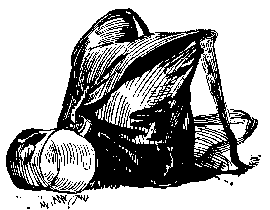

|
WE ARE LIMITING THE WORK WE TAKE ON AT THIS TIME. PROJECTS FOR FRIENDS AND ESTABLISHED CUSTOMERS ARE OUR FIRST PRIORITY.
THANK YOU TO OUR LOYAL CUSTOMERS AND THANK YOU FOR VISITING OUR WEBSITE. JP |
|
 |
Many issue
and private purchase cups and dippers were carried by soldiers on both
sides of the Civil War. This is a reproduction of a type issued to
troops by the federal government. Paul Hedren in his article Army
Tincups on the Western Frontier ("Military Collector and
Historian", Vol. XLIV No. 2, Summer 1992) refers to this as a Civil War
Type 2 cup. He says, "This pattern ... typically measures only 2 7/8
inches high 4 1/8 inches diameter. Subtle dimensional differences are
known for this squat-sized variant, and some Type 2 specimens have a
shallow taper from top to bottom." One is pictured in Francis Lord's Civil
War Collector's Encyclopedia and is atrributed to Daniel Heyden,
Co. E, 149th N.Y. Infantry. This reproduction is VERY sturdy with, all
folded seams, wired edges, and a handle that is wired and riveted to
the body of the cup. Price: $30.00 |
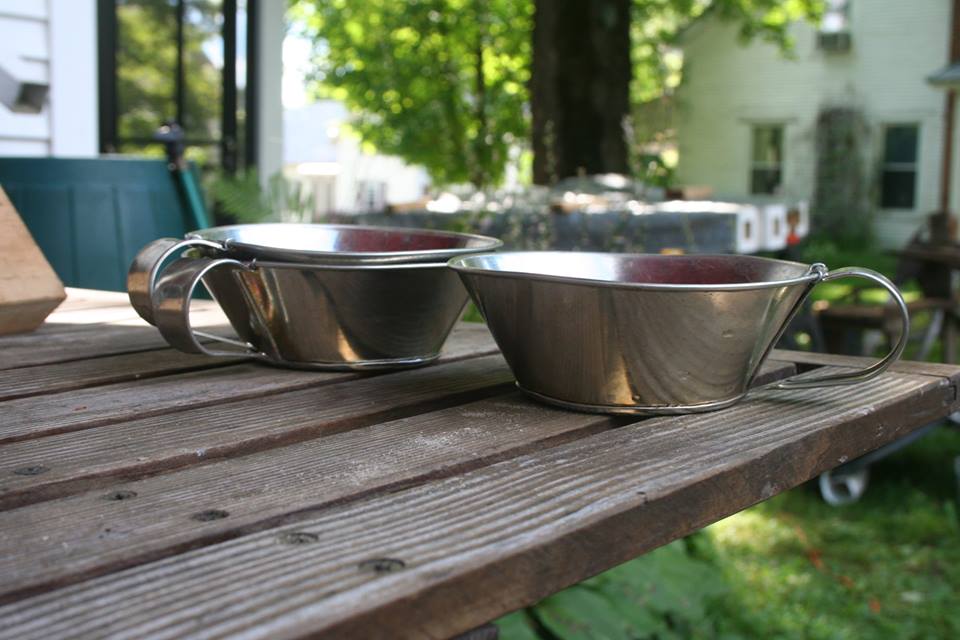 |
The Bertrand Cup The
Bertrand was a steamboat bound for Monatana Territory that sunk on the
Missouri River in 1865. The river eventually changed its course and the
Bertrand was covered in silt. Excavated by archeologists, the site
yielded a trove of artifacts from the period. Stacks of these cups were
found among the cargo. This very utilitarian item can be used as a
drinking cup, a bowl or a plate not to mention trial panning for gold.
|
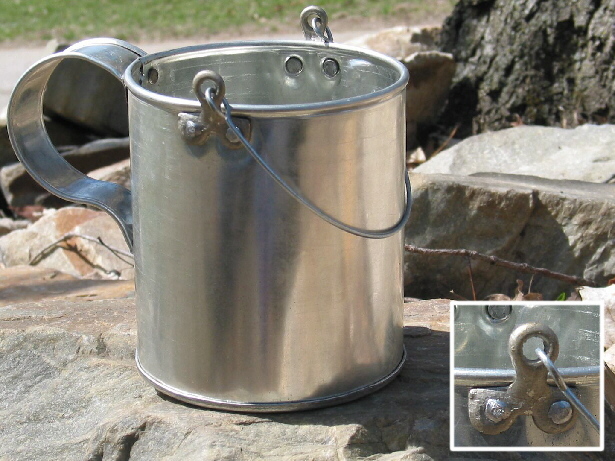 |
I am no longer selling this boiler/cup with cast ears and bail to the general public. |
 Reproduction of the Reynold's
cup seen in Confederate Echoes of Glory. Construction is with
all folded and locked seams and the handle is riveted on. (It can boil
dry on a fire and will not fall apart, although the solder might run.)
A unique feature is the folded rim on the bottom which has not been
rolled up over the sides. Reproduction of the Reynold's
cup seen in Confederate Echoes of Glory. Construction is with
all folded and locked seams and the handle is riveted on. (It can boil
dry on a fire and will not fall apart, although the solder might run.)
A unique feature is the folded rim on the bottom which has not been
rolled up over the sides. Price: $25.00 |

T. V. Brooke style
cup,
also from Confederate Echoes of Glory. It is soldered
construction with the handle riveted on. An ogee bead as would be found
on period stove pipe reinforces the cup. |
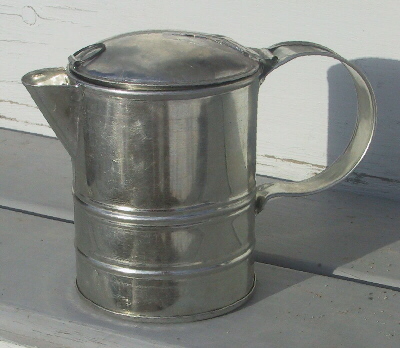 |
This straight sided coffee pot is typical of the
types found in various "camp chests" sold during the Civil War. Tapered
side pots were used as well but the preponderance of originals in that
style found today reflects their
popularity on the civilian market for decades before and after the Civil
War. Price: $85.00 |
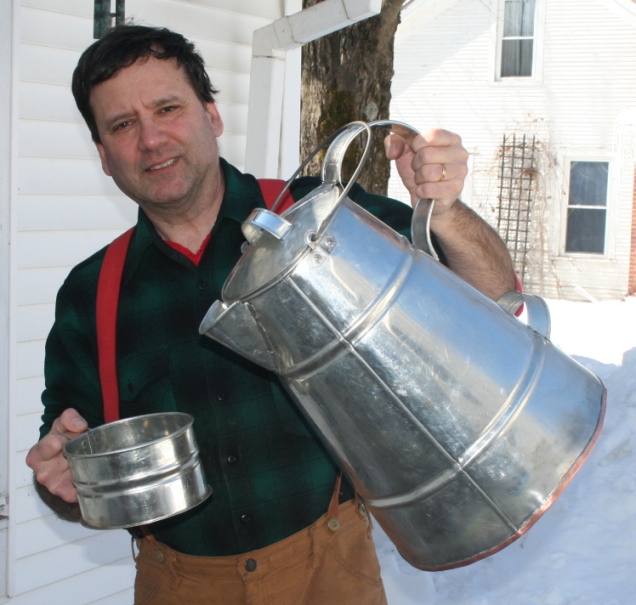 |
This five gallon coffee pot is based on a description of the large pots used by the US Christian Commission to dispense coffee to the soldiers. Before ordering it is important to understand that full this is a very heavy pot - about fifty pounds - too large for a typical campfire. There are several options for this pot including a domed (as seen here) or conical top, a knob instead of a D-pull handle, and a copper bottom. Base price for an all-tin pot with no bail and flat top without a hinge is $180. A copper bottom (depending on the current price of copper) adds $60 +/- to the price. Consult for options, pricing and shipping charge. |

|
This covered boiler, often referred to erroneously by Civil
War reenactors
as a "mucket" (the "mucket" was a larger vessel) measures about 4
inches in diameter and 6 inches tall, and is constructed for
durability.
The domed lid is hinged to the handle. The handle is fastened to the
body with three rivets: two at the top and one at the bottom. All seams
are folded and crimped. The ears that hold the bail are untinned sheet
iron held in place with rivets. This reproduction is different from
others commonly sold in that the cover has a deeper dome to it and the
ears are not simply folded from flat sheet stock but are shaped.
Like the Type 2 cup, the original that this is based on can be found in
Francis Lord's Civil War Collector's Encyclopedia and is
atrributed to Daniel Heyden, Co. E, 149th N.Y. Infantry. |
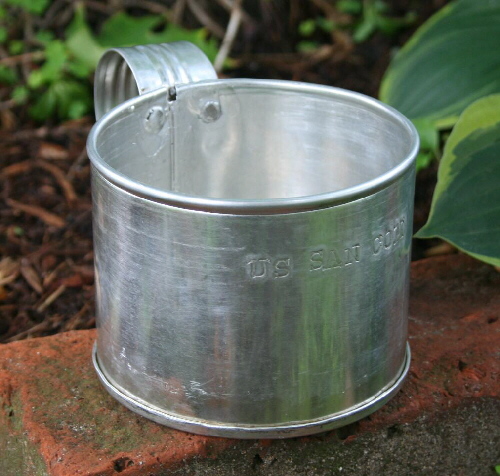 |
This is the larger of 2 United States Sanitary Commission cups made and sold by Otter Creek Tinware. It is stamped US SAN COM. A similar cup can be found in Union Echoes of Glory. Price: $30.00. |
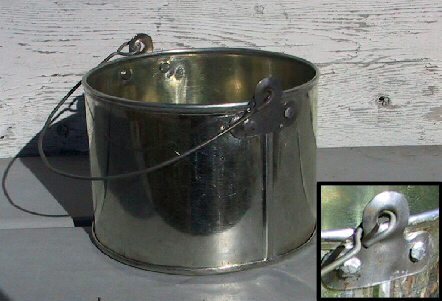 This
small boiler measures 5"
diameter, 3 and 1/2" tall and holds approximately one quart (32 ounces.) Boilers like these would
have been available on the civilian market either alone or as nested
sets from about 1825 to 1880. This is the smallest size that would
generally have been made. It would serve an individual well or could be
shared by a small enlisted mess. The lip is wired and rolled, the seams
are all folded and crimped, and the ears are riveted in place. This
means that should one boil dry, it will not fall apart. I would also
like to point out the ears for the bail - these are heavier gauge untinned sheet iron that has been shaped and hand-riveted to the body.
These are like the stamped ears more typically found on period tinware
than the folded flat stock ears on most "sutler row" tinware that are
machine-riveted in place. When ordering be sure to specify "small uncovered boiler."
Price: $40.00 This
small boiler measures 5"
diameter, 3 and 1/2" tall and holds approximately one quart (32 ounces.) Boilers like these would
have been available on the civilian market either alone or as nested
sets from about 1825 to 1880. This is the smallest size that would
generally have been made. It would serve an individual well or could be
shared by a small enlisted mess. The lip is wired and rolled, the seams
are all folded and crimped, and the ears are riveted in place. This
means that should one boil dry, it will not fall apart. I would also
like to point out the ears for the bail - these are heavier gauge untinned sheet iron that has been shaped and hand-riveted to the body.
These are like the stamped ears more typically found on period tinware
than the folded flat stock ears on most "sutler row" tinware that are
machine-riveted in place. When ordering be sure to specify "small uncovered boiler."
Price: $40.00 |
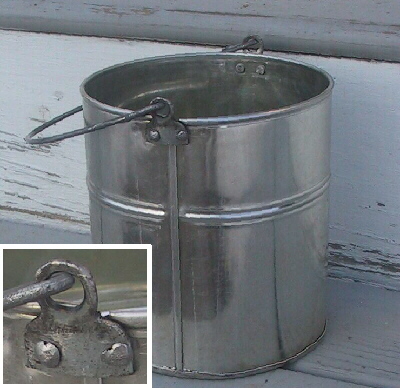 Boilers like
this three quart sized one
were common during the mid 19th century. Sets of nested boilers
were used by regimental and company cooks. Unlike many reproductions
currently sold this features heavy iron ears for the bail rather than
"imported" sheet metal ears that are simply folded. When available they
are $65.00 each. Be sure to specify "3 quart boiler." Boilers like
this three quart sized one
were common during the mid 19th century. Sets of nested boilers
were used by regimental and company cooks. Unlike many reproductions
currently sold this features heavy iron ears for the bail rather than
"imported" sheet metal ears that are simply folded. When available they
are $65.00 each. Be sure to specify "3 quart boiler." |
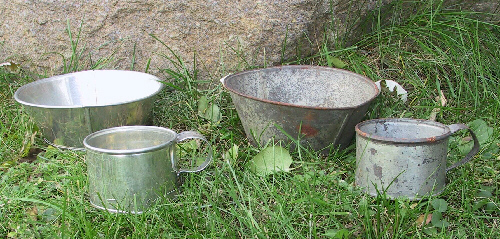 On the
right are a cup and bowl I found in the wall of an1880s back
addition to my house along with a couple of Federal general staff
buttons and a spoon stamped "Eagle Hotel." I wish I knew who placed
these items there and why. On the left are my reproductions of the bowl
and cup. Both are very common tin items that would have been available
on the civilian market during the middle decades of the nineteenth
century. The cup is rather small and measures 3" diameter to about 2"
height. The bowl is 6" diameter across the top and 2 1/4" tall. I have
heard some people call these bowls "coffee coolers" and while that is a
period expression, I do not know if that is a reenactorism as
applied to this item. The bowl fits very well into an authentically
sized haversack and I generally prefer it to a plate. (I also keep mine
on the kitchen shelf at home for my morning oatmeal.) Reproductions of
the bowl are $25.00 each and the cup, $18.00 each. For people who are
interested in the set they are $40.00 together. On the
right are a cup and bowl I found in the wall of an1880s back
addition to my house along with a couple of Federal general staff
buttons and a spoon stamped "Eagle Hotel." I wish I knew who placed
these items there and why. On the left are my reproductions of the bowl
and cup. Both are very common tin items that would have been available
on the civilian market during the middle decades of the nineteenth
century. The cup is rather small and measures 3" diameter to about 2"
height. The bowl is 6" diameter across the top and 2 1/4" tall. I have
heard some people call these bowls "coffee coolers" and while that is a
period expression, I do not know if that is a reenactorism as
applied to this item. The bowl fits very well into an authentically
sized haversack and I generally prefer it to a plate. (I also keep mine
on the kitchen shelf at home for my morning oatmeal.) Reproductions of
the bowl are $25.00 each and the cup, $18.00 each. For people who are
interested in the set they are $40.00 together. |
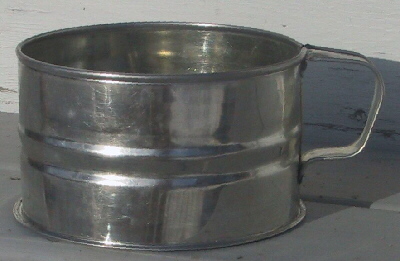 The appearance of this item is
deceiving - it measures a hefty 6"
in diameter and is 3 and 1/2" deep. The original that this is based on
was being offered for sale by Anderson Militaria. It would serve in the
role of a porringer - a combination bowl, plate and drinking vessel. It
would be a perfect coffee cooler - exposing a lot of surface area.
Before you even think about ordering this item make sure you get a
ruler and visualize the proportions - it is BIG! The appearance of this item is
deceiving - it measures a hefty 6"
in diameter and is 3 and 1/2" deep. The original that this is based on
was being offered for sale by Anderson Militaria. It would serve in the
role of a porringer - a combination bowl, plate and drinking vessel. It
would be a perfect coffee cooler - exposing a lot of surface area.
Before you even think about ordering this item make sure you get a
ruler and visualize the proportions - it is BIG!$35.00 |
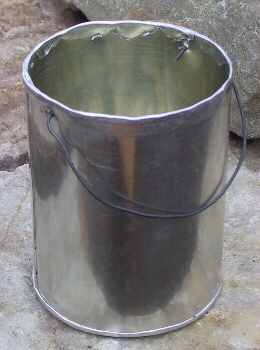 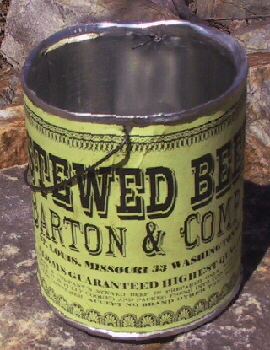 The Civil War increased the
demand for tinned food. Soldiers could "recycle" tin cans, turning them
into impromptu boilers like the one on the left. While can
openers were being patented in the period, they were not in general use
- a soldier would be more apt to use a pocket knife or bayonet to hack
the can open. Notice
the jagged edges that have been turned in and beaten down. While
authentic, this presents a danger to users when drinking from the rim. Otter Creek Tinware assumes no
responsibility for shredded lips and lacerated tongues! The bail
is a scrap of iron wire and the holes were punched with a bayonet. The tin can
boiler pictured
here is $25.00 with or without label. Specify choice of label if desired. The Civil War increased the
demand for tinned food. Soldiers could "recycle" tin cans, turning them
into impromptu boilers like the one on the left. While can
openers were being patented in the period, they were not in general use
- a soldier would be more apt to use a pocket knife or bayonet to hack
the can open. Notice
the jagged edges that have been turned in and beaten down. While
authentic, this presents a danger to users when drinking from the rim. Otter Creek Tinware assumes no
responsibility for shredded lips and lacerated tongues! The bail
is a scrap of iron wire and the holes were punched with a bayonet. The tin can
boiler pictured
here is $25.00 with or without label. Specify choice of label if desired. |
|
Current choice of labels: A -TOMATOES B - STEWED BEEF W/ RED HIGHLIGHTS C - STEWED BEEF ON YELLOW BACKGROUND D - PIE MEAT E - OYSTERS 2 COLOR (BLUE AND BLACK) F - OYSTERS 3 COLOR (RED, BLUE AND BLACK)
|
|
|
|
HOW TIN CANS WERE SEALED AND OPENED IN THE MID NINETEENTH CENTURY: The most common method for filling and sealing tin cans in the period was to ...
1) assemble the can with a large filling hole in the top 2) put the contents in the can 3) solder a disc with a small vent hole punched in it over the filling hole (note: sometimes the vent hole was to the side on the top of the can and the disc did not have a hole in it) 4) place the cans in a boiling bath until contents of cans are boiling and steam is escaping through the vent hole 5) seal the vent hole with a drop of solder
By the late 1870s prestamped tops and bottoms were widely available with a depression in the center to accomodate the filler cap. This allowed the cans to nest neatly and made stacking them easier.
Can openers were available in the 1860s but did not come into common use until later. Cans found in dump sites dating to the Civil War are typically opened with a blade (probably a pocket knife) by either cutting three sides to form a door, cutting an "X" in the top and folding back the resulting triangles, or cutting a circle inside the perimeter of the top of the can.
The cans in the picture above were made for an exhibit at the Genesee Country Village and Museum. Special orders for cans with authentically sealed tops can be accomodated for $8 extra per can.
|